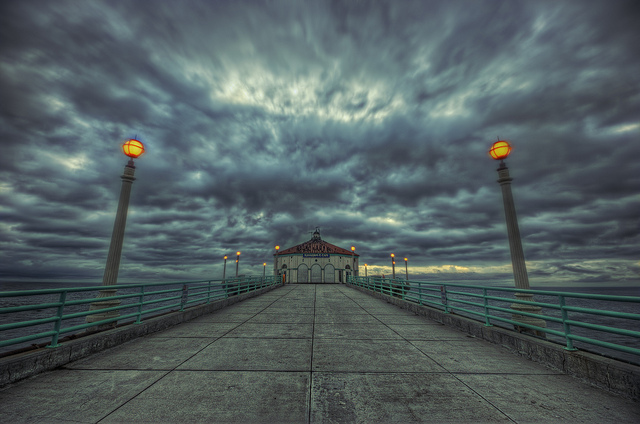Podcast: Play in new window | Download
Subscribe: RSS

A storm gathers over Manhattan Beach, California. But the real threat to the West Coast is from what’s happening in the water, not in the air. (Photo by Neil Kremer/Flickr)
When three or more meteorological disturbances merge, the result is called a “perfect” storm to signify that it is more destructive than the sum of its parts. In the Pacific Ocean off our West Coast, a confluence of dire events is forgathering whose cumulative effect may destroy more life on earth than anything that has occurred in 300 million years. That is not hyperbole, it is the considered opinion of a number of oceanographers who have begun to look at the threats cumulatively, rather than in the confines of one specialty or another. What happened 200 million years ago is called the Great Death of the Permian Age, during which most living things on Earth died.
What is happening today in the eastern Pacific Ocean is thought by some experts to be a runup to just such an event, beginning, as did the Great Death, with the extinction of most life in the ocean. The Global Ocean Commission, in a report issued this summer, assessed the threats to all the oceans this way:
“Climate change and pollution are wreaking havoc on the natural wealth of ocean ecosystems and jeopardizing the services they provide to humanity … Today’s rate of acidification is unparalleled in the last 300 million years. The ‘deadly trio’ of accelerating acidification, warming and deoxygenation are already damaging highly valuable coral reefs and other vulnerable ecosystems. Scientists are observing changes that are progressive, relentless, and unprecedented. It has been projected that up to 60% of ocean species could be extinct by 2050 if climate change is not urgently addressed.”
All these afflictions are now besetting our Pacific Coast. Consider the parts of the gathering storm:
Warming: The ocean, like the land and air, does not warm uniformly or consistently. Despite normal sea-surface temperatures in the central Pacific, for example, an enormous gyre of exceptionally warm water has formed that extends from the Gulf of Alaska to offshore California. It is about a year old, and unlike such phenomena as El Nino has never been observed before. “Such conditions could be hard on next year’s juvenile fish migrations and older salmonids already at sea,” according to NOAA scientist Nate Mantua. And their interference with nutrient transport into subtropical waters is expected to dramatically reduce the productivity of the eastern subtropics over an area of ~6,500 square miles, as calculated by the North Pacific Marine Science Organization.
Acidification: NOAA reported in April that the pH of Pacific waters off the West Coast had become so low (more acidic) that they were dissolving the shells of small snails that are a main food source for several valued species of fish. The shellfish industry and the fisheries all along the coast are in serious decline, at least partly because of “acidification.” (That is what it is called, although the water is not yet technically acidic, it is becoming less alkaline.)
Hypoxia (deoxygenation): We are familiar with oxygen-deprived dead zones, for example in the Gulf of Mexico and the Chesapeake Bay, in which nothing can live. For reasons that seem related to climate change, areas of hypoxia are appearing all along the West Coast, posing an additional threat to sea life of all kinds.
These three bad actors have taken the stage relatively recently, their depredations occurring in addition to the more traditional ones: brutal over-harvesting of popular fish and shellfish, and massive pollution of the waters with sewage, agricultural and storm runoff, and plastic.
The upshot of all this is an increasingly dystopian coast, with pelicans falling dead from the skies, sea lions convulsing to death on beaches littered with dead fish, and, in the depths, an ominous absence of sardines and plankton, which is akin to going to the Great Plains and finding no grass.
The gathering storm is becoming a perfect storm while we watch, assuming that it has nothing to do with us.
Yeah, the relentless march to our own extinction proceeds with or without our witnessing it, believing it, or preparing for it (as if . . .). Thanks for this post. i’ll spread it around.
too bad our lifestyle is non-negotiable and the best we can do is have a bunch of well meaning fools marching for someone to change what is unfolding. i guess most people don’t have mirrors in their homes… sigh.
Another excellent summation. Youngest daughter who is studying sea otters in the Monterey Bay for her PhD thesis sent me this article which makes me suspect the futility of it does not escape her. My heart is breaking for her and all the young people who can do nothing but tally the damage. http://opinionator.blogs.nytimes.com/2014/09/13/useless-creatures/
And the reason that radiation is not a factor is?
Hasn’t got there yet, as far as I know. Lot of worry, might be the Next Big Thing.